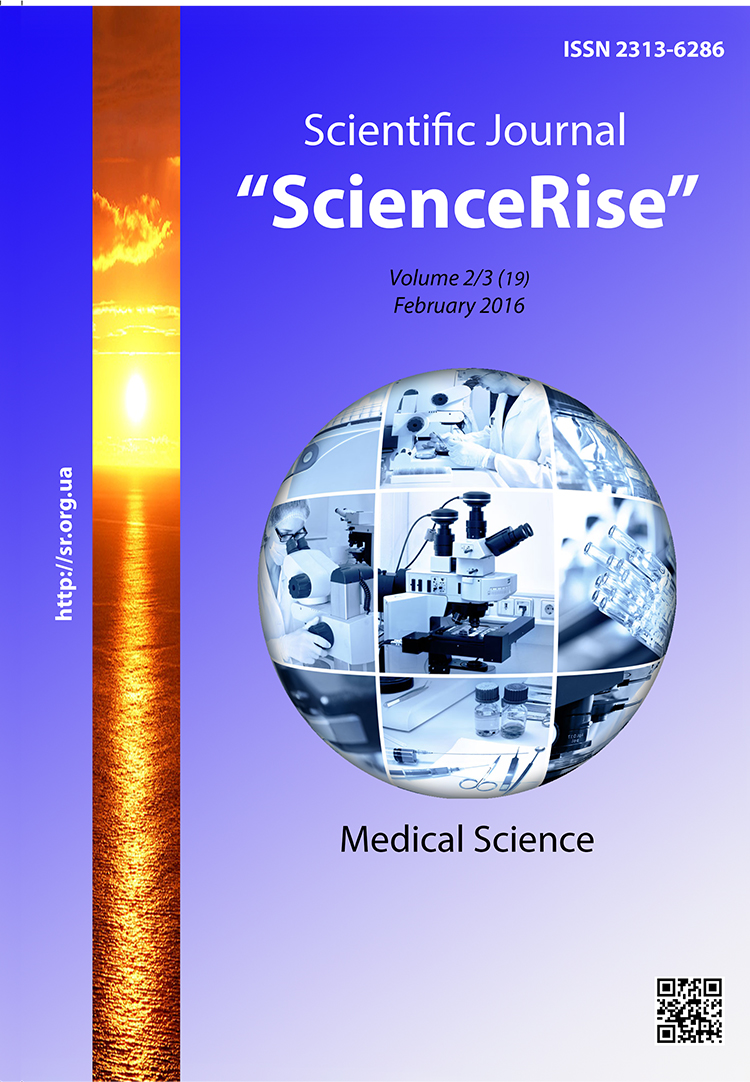Perspectives of the use of commissure in patients with oblique fractures of the lower jaw
DOI :
https://doi.org/10.15587/2313-8416.2016.61055Mots-clés :
lower jaw fracture, head dislocation, splinter displacement, osteosynthesis, commissureRésumé
There was carried out an analysis of the results of treatment of 34 patients with oblique fractures of the lower jaw by the method of commissure osteosynthesis that was elaborated by the authors.
Aim: to increase the effectiveness of treatment of patients with oblique fractures of the lower jaw at the expense of optimization of commissure osteosynthesis.
Methods: there was carried out examination and operative treatment of 34 patients with oblique fractures of lower jaw of the different localization. In the area of the lower jaw angle – 19 (55,88 %) patients, in the area of the lower jaw body – 12 (35,29 %) persons, the number of patients with fractures of the neck with dislocation of the head of lower jaw was 3 (8,83 %). All patients were the persons of male sex 32–55 years old. The operative treatment was consisted in commissure osteosynthesis according to the method elaborated by the authors.
Results: there were not observed any complication in operated patients during postoperative period. There were not observed the secondary displacement of splinters or inflammatory complications. The consolidation of splinters was clinically observed on 21 day after operation. In remote terms (3 month after osteosynthesis) patients have no complaints the disorders of dental occlusion did not take place.
Conclusions:
An offered method of osteosynthesis with wire suture allows:
1. Eliminate the horizontal displacement of splinters;
2. Eliminate the shortening of the jaw arch and the deviation of occlusion with deformation of the patient’s face;
3. Raise the stability of osteosynthesis.
The remote results testify the high effectiveness of the method that allows recommend it for the wide use in clinical practice
Références
Dolgova, I. V. (2013). Prevention of traumatic osteomyelitis of the mandible. Volgograd, 21.
Efimov, Y. V., Efimov, Y. V., Golbraikh, V. R., Mukhaev, H. H., Ivanov, P. V., Efimova, E. Yu. (2010). Surgery of the teeth and oral cavity guidance. Moscow, 136.
Kitshoff, A. M., de Rooster, H., Ferreira, S. M., Steenkamp, G. (2012). A retrospective study of 109 dogs with mandibular fractures. Veterinary and Comparative Orthopaedics and Traumatology, 26 (1), 1–5. doi: 10.3415/vcot-12-01-0003
Payne, K. F. B., Tahim, A., Goodson, A. M. C., Colbert, S., Brennan, P. A. (2012). A review of trauma and trauma-related papers published in the British Journal of Oral and Maxillofacial Surgery in 2010–2011. British Journal of Oral and Maxillofacial Surgery, 50 (8), 769–773. doi: 10.1016/j.bjoms.2012.09.003
Telnih, J. R. (2008). The Use of biologically active preparations in prevention of complications in treating patients with traumatic open fractures of the mandible. Dentistry, 4, 56–58.
Bouloux, G. F., Chen, S., Threadgill, J. M. C. (2012). Small and Large Titanium Plates Are Equally Effective for Treating Mandible Fractures. Journal of Oral and Maxillofacial Surgery, 70 (7), 1613–1621. doi: 10.1016/j.joms.2012.02.029
Efimov, E. Y., Krayushkin, A. I., Efimov, V., Shabanova, N. V. (2014). Dimensional characteristics of the front section of the mandible. Pacific medical journal, 3, 30–32.
Sergeev, S. C., Ivanov, P. C., Grigorishin E. C. (2013). Accounting for the strength characteristics of the facial bones when planning surgical interventions. Bulletin of new medical technologies, 20 (2), 212–216.
Zulkina, L. A. (2011). Sexual dimorphism odontometrics characteristics of the residents of the Penza region 21–36 years depending on the parameters of the cranio-facial complex. Volgograd, 23.
Ellis, E. (2013). Open Reduction and Internal Fixation of Combined Angle and Body/Symphysis Fractures of the Mandible: How Much Fixation Is Enough? Journal of Oral and Maxillofacial Surgery, 71 (4), 726–733. doi: 10.1016/j.joms.2012.09.017
Gokkulakrishnan, S. (2012). An analysis of postoperative complications and efficacy of 3-D miniplates in fixation of mandibular fractures. Dent. Res. J., 9 (4), 414–421.
Téléchargements
Publié-e
Numéro
Rubrique
Licence
(c) Tous droits réservés Yuri Efimov, Dmitry Stomatov, Evgeniya Efimova, Alexander Stomatov, Valery Borodin 2016

Cette œuvre est sous licence Creative Commons Attribution 4.0 International.
Our journal abides by the Creative Commons CC BY copyright rights and permissions for open access journals.
Authors, who are published in this journal, agree to the following conditions:
1. The authors reserve the right to authorship of the work and pass the first publication right of this work to the journal under the terms of a Creative Commons CC BY, which allows others to freely distribute the published research with the obligatory reference to the authors of the original work and the first publication of the work in this journal.
2. The authors have the right to conclude separate supplement agreements that relate to non-exclusive work distribution in the form in which it has been published by the journal (for example, to upload the work to the online storage of the journal or publish it as part of a monograph), provided that the reference to the first publication of the work in this journal is included.

